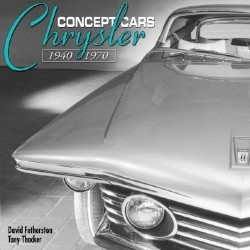It looks like you've stumbled upon a page meant to be read by our code instead of viewed directly. You're probably looking for this page.
Chrysler Concept Cars 1940-1970
“The Airflow had a lumbering, stupid look, a rhinoceros ugliness,” wrote styling historian Paul Wilson. The “streamlined” 1934 Chrysler Airflow was the company’s biggest design mistake—the Airflop, as acerbic pundits called it. Even the redesign of the “waterfall” grille didn’t stem the tide of poor sales. Clearly, Chrysler needed styling.
In Chrysler Concept Cars 1940-1970, David Fetherston, author of numerous books including American Woody, and Tony Thacker, former editor of Custom Car magazine, present three decades of innovative car designs that followed the Airflow fiasco. The new designs were to represent Chrysler’s philosophy that beauty should be the “sheer by-product of engineering integrity.” The most significant concept car of the forties was the Golden Arrow. Streamlining was used, but tastefully tempered. The Golden Arrow incorporated a double cowl with visible fender seams, and its art was to later emerge in the Chrysler Imperial parade car.
World War II interrupted car production. Chrysler put aside its trunks and tail lights and began manufacturing such behemoths as the thirty-two ton General Sherman tank with 75mm cannon. After the WWII labor strife, aging management and unimaginative products were chronic problems.
A new management team appeared in the early fifties, and with it a new style strategy called the Forward Look. Designer Virgil Exner used an Italian custom coachbuilding firm, Carrozziere Ghia, which had built automobile bodies since 1915 and whose clients included Alfa Romeo and Lancia. The first exotic concept was the 1951 Chrysler K-310 with its stylized spare tire element in the surface of the trunk lid and gunsight taillights. Following that was the 1952 Chrysler C-200 was an elegant design featuring a folded tonneau. Other concepts included the 1956 Chrysler Norseman with vertical and horizontal fins, but after it was sent from Genoa, Italy, it sunk off the coast of Nantucket in the hold of the Andrea Doria. Later concept cars included the “car of the future,” the 1963 Chrysler Turbine with jet-like exhausts, and the 1968 Dodge Charger III featuring an aircraft-style canopy.
Chrysler Concept Cars’ more than 100 photographs illustrate the beauty and ingenuity from the design departments. The book, however, could have been improved with more overall company history and the automobile designs’ translations into sales. Interesting were the final design tussles of personalities.
This is a connoisseur’s book of fast lines and sculpted curves.
Disclosure: This article is not an endorsement, but a review. The publisher of this book provided free copies of the book to have their book reviewed by a professional reviewer. No fee was paid by the publisher for this review. Foreword Reviews only recommends books that we love. Foreword Magazine, Inc. is disclosing this in accordance with the Federal Trade Commission’s 16 CFR, Part 255.
